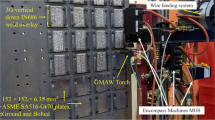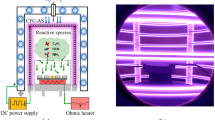Abstract
The use of superaustenitic stainless steels (SASS) as an overlay replacement for nickel-based alloys can be an interesting alternative for the oil and gas industries, due to its lower cost, when compared to superalloys. Usually, the deposition is made with several welding passes by using conventional arc welding processes, such as gas tungsten arc welding (GTAW) or gas metal arc welding (GMAW) processes. In this respect, electro-slag welding (ESW), which promotes high heat inputs and low dilution of the welds, can also be attractive for this application, as it provides a higher productivity, once only one layer is needed for the deposition of the minimum thickness required. The present work evaluates the behavior of an AISI 904L SASS weld overlay deposited on a carbon steel ASTM A516 Grade 70 by ESW and GMAW processes. Both as-welded and heat-treated conditions were evaluated and compared. A multipass welding by GMAW process with three layers and 48 passes was performed on 12.5 × 200 × 250 mm steel plates with average welding energy of 1.0 kJ/mm. For ESW process, only one layer was deposited on 50 × 400 × 400 mm steel plates with average welding energy of 11.7 kJ/mm. After welding, a post-weld heat treatment (PWHT) at 620 °C for 10 h was performed in half of the steel plate, in order to allow the comparison between this condition and the as-welded one. For both processes, the austenitic microstructure of the weld deposits was characterized by optical microscopy and scanning electron microscopy with electron backscatter diffraction. A low proportion of secondary phases were observed in all conditions, and the PWHT did not promote significant changes on the hardness profile. Martensite for GMAW process and bainite for ESW process were the microstructural constituents observed at the coarse grain heat-affected zone, due to the different cooling rates. For ESW process, no evidences of partially diluted zones were found. As a consequence of the microstructural findings, the hardness results for ESW were lower than those usually observed for other electric arc welding processes. In addition, specimens subject to bending tests performed in accordance with the current standards used for qualification of welding procedures were approved. These evidences allow the conclusion that the ESW process can provide deposits with high quality despite the high welding energy levels, in order to achieve the desired productivity, being an interesting alternative for AISI 904L weld overlays.










Similar content being viewed by others
References
J. Anburaj, S.S. Mohamed Nazirudeen, R. Narayanan, B. Anandavel, and A. Chandrasekar, Ageing of Forged Superaustenitic Stainless Steel: Precipitate Phases and Mechanical Properties, Mater. Sci. Eng. A, 2012, 535, p 99–107
T. Koutsoukis, A. Redjaımia, and G. Fourlaris, Phase Transformations and Mechanical Properties in Heat Treated Superaustenitic Stainless Steels, Mater. Sci. Eng. A, 2013, 561, p 477–485
K. Bang, S. Pak, and S. Ahn, Evaluation of Weld Metal Hot Cracking Susceptibility in Superaustenitic Stainless Steel, Met. Mater. Int., 2013, 19(6), p 1267–1273
P. Sathiya, S. Aravindan, P.M. Atjith, B. Arivazhagan, and A. Noorul Haq, Microstructural Characteristics on Bead on Plate Welding of AISI, 904L Super Austenitic Stainless Steel Using Gas Metal Arc Welding Process, Int. J. Eng. Sci. Technol., 2010, 2(6), p 189–199
Z. Bogdanowicz, P. Jozwik, and B. Nasilowska, Microstructure and Mechanical Behavior of a CO2 Laser and TIG Welded 904L Steel, Metal. Found. Eng., 2014, 40(2), p 69–81
K.D. Ramkumar, A. Choudhary, S. Aggarwal, A. Srivastava, T.H. Mohan, and N. Arivazhagan, Characterization of Microstructure and Mechanical Properties of Continuous and Pulsed Gas Tungsten Arc Welded Superaustenitic Stainless Steel, J. Mater. Res., 2015, 30(10), p 1727–1746
Norsok Standard, M-001, Materials Selection, Rev.3. Oslo, Norway, November, 2002
Y. Wu, B.M. Patchett, and C. Bicknell, The Interfacial Microstructure of Weld Overlay of Corrosion Resistant Alloys, Scr. Metal. Mater., 1994, 30(9), p 1133–1138
K. Balamurugan, M.K. Mishra, P. Sathiya, and A.N. Sait, Weldability Studies and Parameter Optimization of AISI, 904L Super Austenitic Stainless Steel Using Friction Welding, Mater. Res., 2014, 17(4), p 908–919
F.A.P. Fernandes, L.C. Casteletti, and J. Gallego, Microstructure of Nitrided and Nitrocarburized Layers Produced on a Superaustenitic Stainless Steel, J. Mater. Res. Technol., 2013, 2(2), p 158–164
S.D. Kahar, Review on Electro-Slag Strip Cladded Weld Overlays, Int. J. Adv. Eng. Res. Dev., 2016, 3(8), p 1–8
R. Paschold, L. Karlsson, and M.F. Gittos, Disbonding of Austenitic Weld Overlays in Hydroprocessing Applications, Svetsaren, 2007, 62(1), p 10–15
American Welding Society, Specification for Bare Stainless Steel Welding Electrodes and Rods, AWS A5.9/A5.9M:2006, 2006
European Norm, Welding consumables. Fluxes for submerged arc welding. Classification, EN-760, 1996
American Welding Society, Specification for Bare Stainless Steel Welding Electrodes and Rods, AWS A5.9/A5.9M:2006, Miami, 2006
American Society for Mechanical Engineers, ASME Boiler and Pressure Vessel Code, Welding, Brazing, and Fusing Qualifications, Section IX, New York, 2013
N. Farkade and P.N. Ravanan, Modification in Weld Overlay for Productivity and Corrosion Resistance, Int. J. Sci. Technol. Eng., 2015, 2(2), p 37–41
D. Myres, Metal Cored Wires: Advantages and Disadvantages, Weld. J., 2002, 81(9), p 39–42
T. Niraj and R. Yadav, Electro Slag Strip Cladding Process, Int. J. Mod. Eng. Res., 2014, 4(7), p 60–64
N. Murugan and R.S. Parmar, Stainless Steel Cladding Deposited by Automatic Gas Metal Arc Welding, Weld. J., 1997, 76(10), p 391–403
B. Rutzinger, Influence of the Welding Process to the Dilution Rate of Weld Overlays on Unalloyed Steel Using the Weld Consumable ERNiCrMo-3 (Alloy 625), Biuletyn Instytutu Spawalnictwa, 2014, 5, p 72–75
F.C.A. Madalena, C.P. Alvarães, L.F.G. Souza, J.C.F. Jorge, and L.S. Araújo, Mechanical and Microstructural Properties of the Inconel 625 Alloy Weld Overlay Obtained by Electroslag Welding Process, Proceedings of the 23rd ABCM International Congress of Mechanical Engineering, Rio de Janeiro, Brazil, 2015
J.S. Kim, Y.I. Park, and H.W. Lee, Effects of Heat Input on the Pitting Resistance of Inconel 625 Welds by Overlay Welding, Metall. Mater. Int., 2015, 21(2), p 350–355
N.Z. Kejelin, A.J.A. Buschinelli, and A.M. Pope, Effect of Welding Parameters on the Partially Diluted Zones Formation at Dissimilar Metal Welds, Proceedings of the 18th International Congress of Mechanical Engineering, Ouro Preto, Brazil, 2005
A.A. Omar, Effects of Welding Parameters on Hard Zone Formation at Dissimilar Metal Welds, Weld. J., 1998, 77(2), p 83s–93s
M.F. Gittos, J.L. Robinson, and T.G. Gooch, Disbonding of Austenitic Stainless Steel Cladding Following High Temperature Hydrogen Service, Weld. World, 2008, 52(3), p 54–67
T. Doody, Intermediate Mixed Zones in Dissimilar Metal Welds for Sour Service, Weld. J., 1992, 71(3), p 55–60
M.D. Rowe, T.W. Nelson, and J.C. Lippold, Hydrogen-Induced Cracking Along the Fusion Boundary of Dissimilar Metal Welds, Weld. J., 1999, 78(2), p 31s–37s
S.A. David, J.M. Vitek, and T.L. Hebble, Effect of Rapid Solidification on Stainless Steel Weld Metal, Weld. J., 1987, 66(10), p 289s–300s
B.A.R.S. Barbosa, F.B. Mainier, J.M. Pardal, and S.S.M. Tavares, Influência da solubilização na resistência a corrosão de revestimento tipo “clad de aço inoxidável AISI, 904L (Influence of Solution Treatment on the Corrosion Resistance of AISI, 904L Stainless Steel Clad), Corrosão e Proteção, 2013, 49(10), p 28–33 ((in Portuguese))
M.J. Cieslak, A.M. Ritter, and W.F. Savage, Chi-Phase Formation During Solidification and Cooling of CF-8M Weld Metal, Weld. J., 1984, 63(4), p 133–140
F.C. Hull, Effects of Composition on Embrittlement of Austenitic Stainless Steels, Weld. J., 1973, 52(3), p 104–113
Y. Kato, M. Ito, Y. Kato, and O. Furukimi, Effect of Si on Precipitation Behavior of Nb-Laves Phase and Amount of Nb in Solid Solution at Elevated Temperature in High Purity 17%Cr-0.5%Nb Steels, Mater. Trans., 2010, 51, p 1531–1535
R.F.A. Jargelius-Petterson, Phase Transformation in a Manganese-Alloyed Austenitic Stainless Steel, Scr. Metall. Mater., 1994, 30, p 1233–1238
C. Hsieh and W. Wu, Overview of Intermetallic Sigma (σ) Phase Precipitation in Stainless Steels. ISRN Metallurgy 2012, Article ID 732471, P1–16, doi:10.5402/2012/732471
I. Satari-Far and M. Andersson, Cladding Effects on Structural Integrity of Nuclear Components, SKI Report 2006.
R.R. Shen, Z. Zhou, P. Liu, and G. Chai, Effects of PWHT on the Microstructure and Mechanical Properties of ERNiCrFe-7 All-Weld Metal, Weld. World, 2015, 59, p 317–323
A.F. Gourgues, H.M. Flower, and T.C. Lindley, Electron Backscattering Diffraction Study of Acicular Ferrite, Bainite and Martensite Steel Microstructures, Mater. Sci. Technol., 2000, 16(1), p 26–40
T. Karthikeyan, M.K. Dash, S. Saroja, and M. Vijayalakshmi, Estimation of Martensite Feature Size in a Low-Carbon Alloy Steel by Microtexture Analysis of Boundaries, Micron, 2015, 68, p 77–90
B.K. Narayanan, L. Kovarik, M.A. Quintana, and M.J. Mills, Characterization of Ferritic Weld Microstructures Using Various Electron Microscopy Techniques: A Review, Sci. Technol. Weld. Join., 2011, 16(1), p 12–22
P. Suikkanen, C. Cyron, A.J. DeArdo, and L.P. Karjalainen, Crystallographic analysis of martensite in 0.2C-2.0Mn-1.5Si-0.6Cr steel using EBSD, J. Mater. Sci. Technol., 2011, 27(10), p 920–930
Acknowledgments
The authors would like to thank CEFET/RJ, COPPE/UFRJ and Petrobras for the support in the execution of the present work.
Author information
Authors and Affiliations
Corresponding author
Rights and permissions
About this article
Cite this article
Jorge, J.C.F., Meira, O.G., Madalena, F.C.A. et al. Evaluation of the AISI 904L Alloy Weld Overlays Obtained by GMAW and Electro-Slag Welding Processes. J. of Materi Eng and Perform 26, 2204–2212 (2017). https://doi.org/10.1007/s11665-017-2631-9
Received:
Revised:
Published:
Issue Date:
DOI: https://doi.org/10.1007/s11665-017-2631-9




